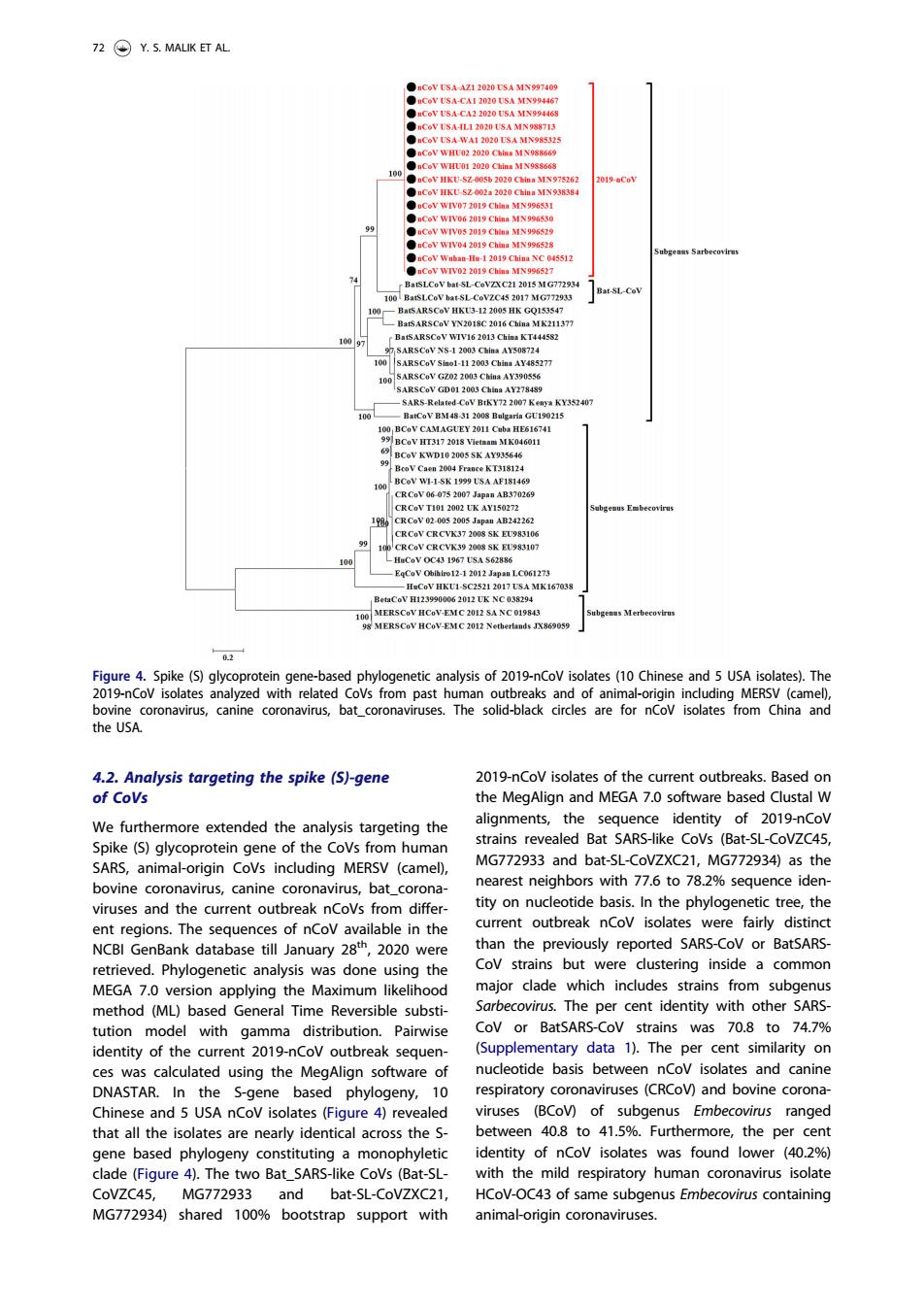正在加载图片...

72④Y.5.MALK ET AL 4.2.Analysis targeting the spike(S)-gene 2019-nCoV isolates of the current outbreaks.Based on of CoVs the MegAlign and MEGA 7.0 software based Clustal W We furthermore extended the alignments,the sequence identity of 2019n0 Spike (S) SARS animal-origin Covs including MERSV (camel nd baat MG7729 4)as 78. bovine coronavirus.canine coronavirus.bat corona viruses and the current outbreak nCovs from diffe current outbreak nCov isolates were fairly distinct sequenc of nCoV available in the data than the previously reported SARS-CoV or BatSARS CoV strains but were clustering inside a commor MEGA 7.0 version applying the Maximum likelihood major clade method (ML)based General Time Reversible substi- The per ce othe tution model with gamma distribution. Pairwise or identity of the cur ent 2019-nCoV outbreak tide basis ing the coronaviruses (CRCov)and bovine cor 4) iruses (BCov)of subgenus Embecovirus rangec that all the isolates are nearly identical across the s between 40.8to41.5%. Furthermore,the per cen gene based phylogeny constitu uting a monophyletic ntity of nCov isolates was found (4029% clade (Figure 4).The two Bat_SARS-like CoVs (Bat-S bat-S 109 suppor4.2. Analysis targeting the spike (S)-gene of CoVs We furthermore extended the analysis targeting the Spike (S) glycoprotein gene of the CoVs from human SARS, animal-origin CoVs including MERSV (camel), bovine coronavirus, canine coronavirus, bat_coronaviruses and the current outbreak nCoVs from different regions. The sequences of nCoV available in the NCBI GenBank database till January 28th, 2020 were retrieved. Phylogenetic analysis was done using the MEGA 7.0 version applying the Maximum likelihood method (ML) based General Time Reversible substitution model with gamma distribution. Pairwise identity of the current 2019-nCoV outbreak sequences was calculated using the MegAlign software of DNASTAR. In the S-gene based phylogeny, 10 Chinese and 5 USA nCoV isolates (Figure 4) revealed that all the isolates are nearly identical across the Sgene based phylogeny constituting a monophyletic clade (Figure 4). The two Bat_SARS-like CoVs (Bat-SLCoVZC45, MG772933 and bat-SL-CoVZXC21, MG772934) shared 100% bootstrap support with 2019-nCoV isolates of the current outbreaks. Based on the MegAlign and MEGA 7.0 software based Clustal W alignments, the sequence identity of 2019-nCoV strains revealed Bat SARS-like CoVs (Bat-SL-CoVZC45, MG772933 and bat-SL-CoVZXC21, MG772934) as the nearest neighbors with 77.6 to 78.2% sequence identity on nucleotide basis. In the phylogenetic tree, the current outbreak nCoV isolates were fairly distinct than the previously reported SARS-CoV or BatSARSCoV strains but were clustering inside a common major clade which includes strains from subgenus Sarbecovirus. The per cent identity with other SARSCoV or BatSARS-CoV strains was 70.8 to 74.7% (Supplementary data 1). The per cent similarity on nucleotide basis between nCoV isolates and canine respiratory coronaviruses (CRCoV) and bovine coronaviruses (BCoV) of subgenus Embecovirus ranged between 40.8 to 41.5%. Furthermore, the per cent identity of nCoV isolates was found lower (40.2%) with the mild respiratory human coronavirus isolate HCoV-OC43 of same subgenus Embecovirus containing animal-origin coronaviruses. Figure 4. Spike (S) glycoprotein gene-based phylogenetic analysis of 2019-nCoV isolates (10 Chinese and 5 USA isolates). The 2019-nCoV isolates analyzed with related CoVs from past human outbreaks and of animal-origin including MERSV (camel), bovine coronavirus, canine coronavirus, bat_coronaviruses. The solid-black circles are for nCoV isolates from China and the USA. 72 Y. S. MALIK ET AL